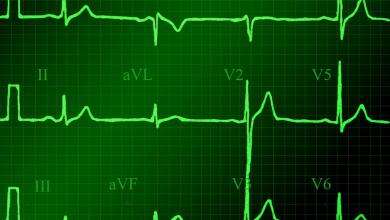Search results
Author(s):
Oholi Tovia-Brodie
,
Yoav Michowitz
,
Bernard Belhassen
Added:
3 years ago
Brugada syndrome (BrS) is a cardiac disease caused by an inherited ion channelopathy. It was first described by the Brugada brothers in 19921 and is associated with a propensity to develop ventricular fibrillation (VF). Brugada syndrome is characterised by prominent J waves appearing as an ST segment elevation in the right precordial leads. In the latest guidelines, diagnosis of BrS constitutes…
View more
Author(s):
Jorge E Romero
,
Dan L Li
,
Ricardo Avendano
,
et al
Added:
3 years ago
Brugada syndrome (BrS), one of the most common causes of sudden cardiac death (SCD) in normal structural heart individuals, is a young entity in modern medicine. BrS was first characterised in 1992 by Brugada et al. as a distinct syndrome with “right bundle branch block, persistent ST elevation in precordial leads V1 to V2–3 and sudden cardiac death”.1 The true prevalence of BrS is not clearly…
View more
Author(s):
Carlo Pappone
,
Vincenzo Santinelli
Added:
3 years ago
Historical Precedents
Brugada syndrome (BrS) was first described more than 25 years ago as a clinical entity in people resuscitated from sudden cardiac death due to documented VF.1 The original 1992 case series described eight patients without apparent structural heart disease who all had VF associated with persistent coved ST-segment elevation in the right precordial leads.1 In 1996 this…
View more
Author(s):
Megan Barber
,
Jason Chinitz
,
Roy John
Added:
3 years ago
Ventricular arrhythmias are designated idiopathic when demonstrable structural heart disease, significant coronary disease including coronary spasm or genetic arrhythmia syndromes are absent.1 These arrhythmias may be benign but are also a recognised cause of sudden cardiac death. The common form of idiopathic ventricular tachycardia (VT) originates in the ventricular outflow tracts, manifest…
View more
Author(s):
Vincent Probst
,
Stéphanie Chatel
,
Jean-Baptiste Gourraud
,
et al
Added:
3 years ago
Brugada syndrome (BrS) is a clinical entity identified in 1992 by Brugada brothers from a file of patients resuscitated from sudden cardiac death (SCD).1 Of these patients, some had a specific electrocardiogram (ECG) appearance characterised by an incomplete right bundle branch block associated with an ST segment elevation in the right precordial leads. It quickly became apparent that this…
View more
Author(s):
Juan Sieira
,
Pedro Brugada
Added:
3 years ago
Brugada syndrome (BS) is an inherited disease characterised by coved-type ST-segment elevation in the right precordial leads (V1–V3) and an increased risk of sudden cardiac death (SCD) in the absence of structural heart disease.1
It typically affects otherwise healthy individuals in their forties.2 SCD is the most dramatic presentation, but many patients are asymptomatic at the time of diagnosis…
View more
Author(s):
Giulio Conte
,
Ulrich Schotten
,
Angelo Auricchio
Added:
3 years ago
The Risk of Atrial Arrhythmias in Inherited Primary Arrhythmia Syndromes
The inherited primary arrhythmia syndromes (IPAS) are a heterogeneous group of diseases caused by mutations in genes encoding for cardiac ion channels. People affected by one of these inherited diseases have no overt structural cardiac abnormalities but are at higher risk of sudden cardiac death due to the occurrence of…
View more
Author(s):
Pascal Vranckx
,
Marco Valgimigli
,
Hein Heidbuchel
Added:
3 years ago
Anticoagulation with vitamin K antagonists (VKAs) has been used for the long-term treatment and prevention of thromboembolic diseases and for stroke prevention in atrial fibrillation (AF) for the past half century. Until the last decade, VKAs were the only oral anticoagulant (OAC) agents available, and warfarin remains the most commonly prescribed OAC worldwide.1 Direct oral anticoagulants (DOACs…
View more
Author(s):
Manoj N Obeyesekere
,
Andrew D Krahn
Added:
3 years ago
Early repolarisation (ER) is defined as J-point elevation of ≥0.1 mV in two adjacent leads with either a slurred or notched morphology (Figures 1 to 4).1,2 Numerous studies have established an association with ER and increased risk of death and idiopathic ventricular fibrillation (VF).1–5 Clinicians face questions such as patient and family counselling, quantitifying the risk of sudden cardiac…
View more
Author(s):
Boris Rudic
,
Rainer Schimpf
,
Martin Borggrefe
Added:
3 years ago
Short QT syndrome (SQTS) is a rare, inheritable channelopathy of the heart characterised by abnormally short QT intervals on the electrocardiogram (ECG) and an increased propensity to develop atrial and ventricular tachyarrhythmias in the absence of structural heart disease.1,2 SQTS was first described as a new clinical entity by Gussak et al. in 2000.1 Until then shortening of the QT interval…
View more













